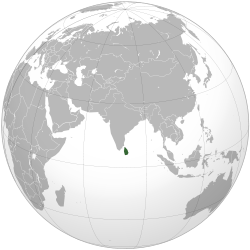Complete ecotouristic information database on national parks of Sri Lanka.
Sri Lanka (former Ceylon) is sometimes called a pearl of Indian Ocean. This island is getting more and  more popular among turists searching for a stay on beaches of a tropical sea. Only a few of those tourist visit to any of Sri Lanka national parks - very valuable from eco-touristic point of view.
more popular among turists searching for a stay on beaches of a tropical sea. Only a few of those tourist visit to any of Sri Lanka national parks - very valuable from eco-touristic point of view.
Sri Lanka is a republic lying on the island called Ceylon close to southeast India.
The mountains and the southwestern part of the country, known as the "wet zone," receive ample rainfall (an annual average of 2500 millimetres). Most of the southeast, east, and northern parts of the country comprise the "dry zone," which receives between 1200 and 1900 mm (47-75 in) of rain annually. Much of the rain in these areas falls from October to January; during the rest of the year there is very little precipitation, and all living creatures must conserve precious moisture. The arid northwest and southeast coasts receive the least amount of rain - 600 to 1200 mm (24-47 in) per year - However, though many say that there are no really dry areas in Sri Lanka, there are many pockets of very dry and abandoned areas where there is little to no rainwater. Varieties of flowering acacias are well adapted to the arid conditions and flourish on the Jaffna Peninsula. Among the trees of the dry-land forests are some valuable species, such as satinwood, ebony, ironwood, and mahogany and teak. In the wet zone, the dominant vegetation of the lowlands is a tropical evergreen forest, with tall trees, broad foliage, and a dense undergrowth of vines and creepers.
and mahogany and teak. In the wet zone, the dominant vegetation of the lowlands is a tropical evergreen forest, with tall trees, broad foliage, and a dense undergrowth of vines and creepers.
Subtropical evergreen forests resembling those of temperate climates flourish in the higher altitudes. Forests at one time covered nearly the entire island, but by the late 20th century lands classified as forests and forest reserves covered around one-third of the land. The Ruhunu National Park in the southeast protects herds of elephant, deer, and peacocks, and the Wilpattu National Park in the northwest preserves the habitats of many water birds, such as storks, pelicans, ibis, and spoonbills. During the Mahaweli Ganga Program of the 1970s and 1980s in northern Sri Lanka, the government set aside four areas of land totaling 1,900 km2 (730 sq mi) as national parks. The island has three biosphere reserves, Hurulu, Sinharaja, and the Kanneliya-Dediyagala-Nakiyadeniya.
The national flower of Sri Lanka is Nil Mahanel (Nymphaeaceae), the national tree is Na (Mesua nagassarium) and the national bird is the Sri Lanka Junglefowl, which is endemic to the country.
Detailed information on Sri Lanka National Parks.
There is a database of this country national parks available. If you have any question or request you can send it by attached Informative Form.